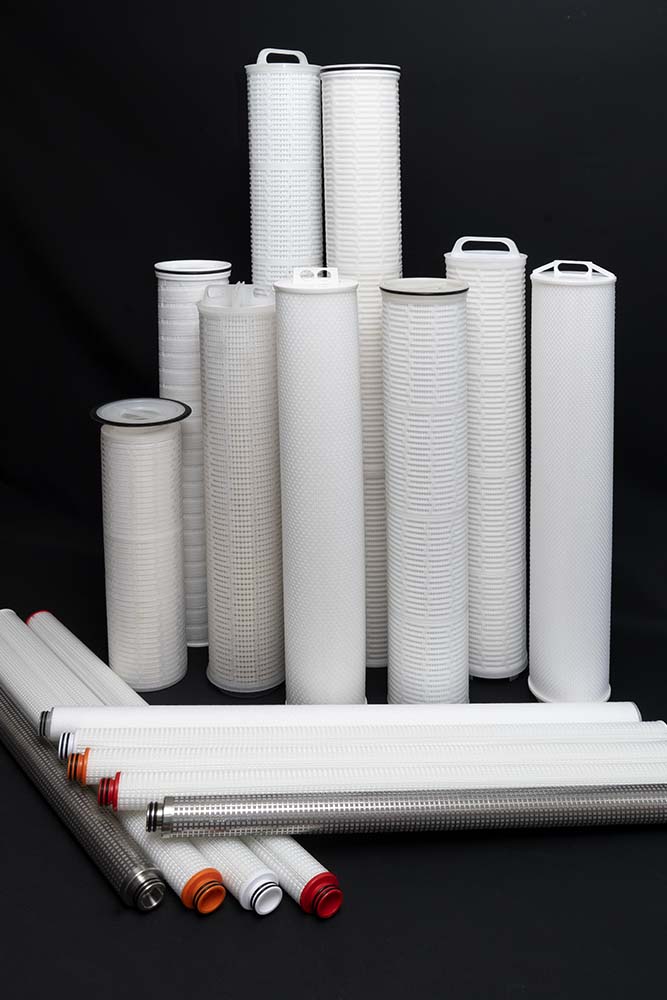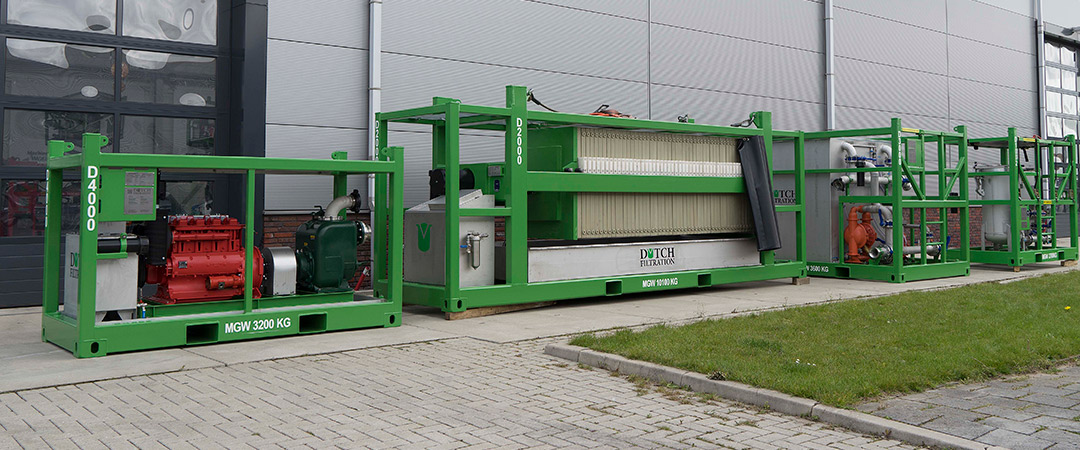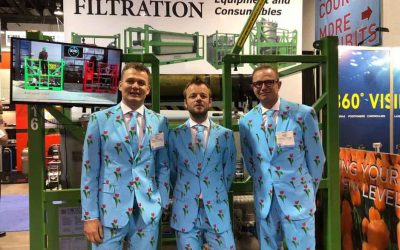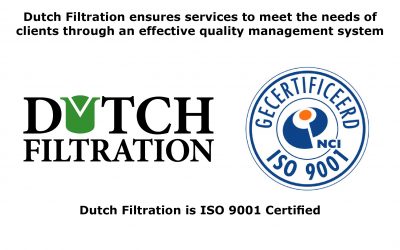Are you new to filtration? Then first read our paper Basics of Filtration
Liquid Filtration, an important step in your process
Liquid filtration is an important step in many industrial processes. Controlling contaminants is important to protect your equipment and instruments, as well as to assure the quality of your product. A filter can help control these problems, but can also act as a monitor for the whole process. For example, a filter that plugs earlier than expected indicates there may be some undesired conditions somewhere in the process.
Filtration removes suspended particles from a fluid or gas by passing the fluid through a porous or semipermeable medium. Not all filtration processes are self-cleaning or without consumables. Filtration at lower micron ratings often requires consumables (filter elements), these are operational expenses (OPEX). Therefore, it’s important to get the highest quality and value to perform consistently every time. Choosing the right filter process with the right filter elements can help you to get a grip on these costs. To protect your supply chain and maintain production it’s important to have stock available when you require it.
All our filter consumables and equipment are fabricated in the Netherlands. We keep stock at our warehouses located in the Netherlands, North America, Australia and Norway. We have a large stock of filter cartridges and equipment ready for delivery to the users. Our team is ready to answer all your technical questions. We know the importance of meeting your production targets and improving your quality, Dutch Filtration provides a reliable filter solution.
Every application requires a different filter solution. It depends on factors such as reliability, cost, efficiency, simplicity and consistency. The decision what filter cartridge you need to use for your process can be challenging. That’s why it’s important to understand the different types of cartridges.
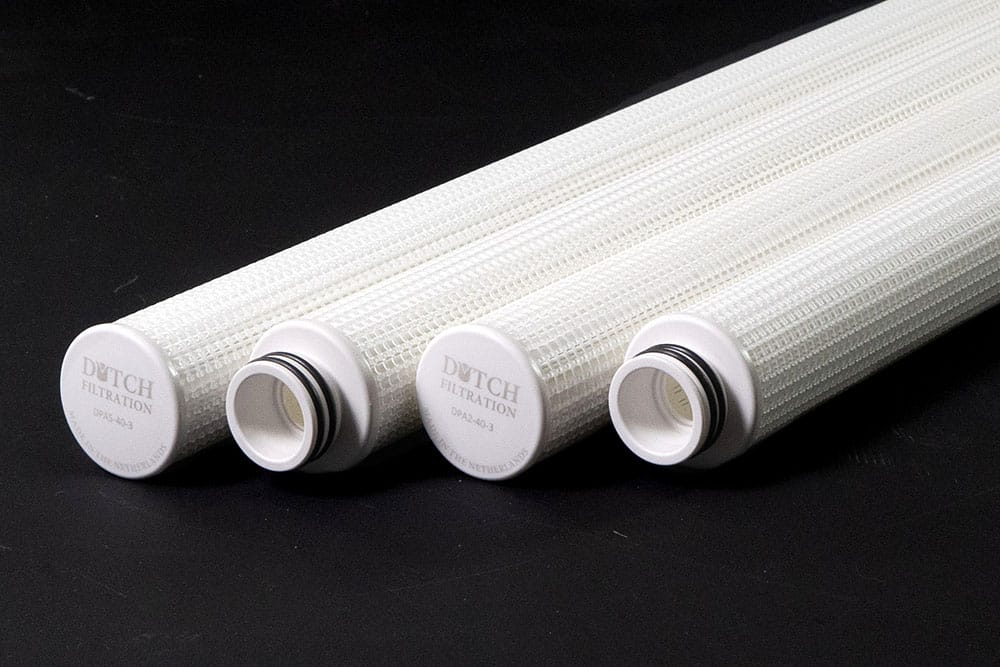
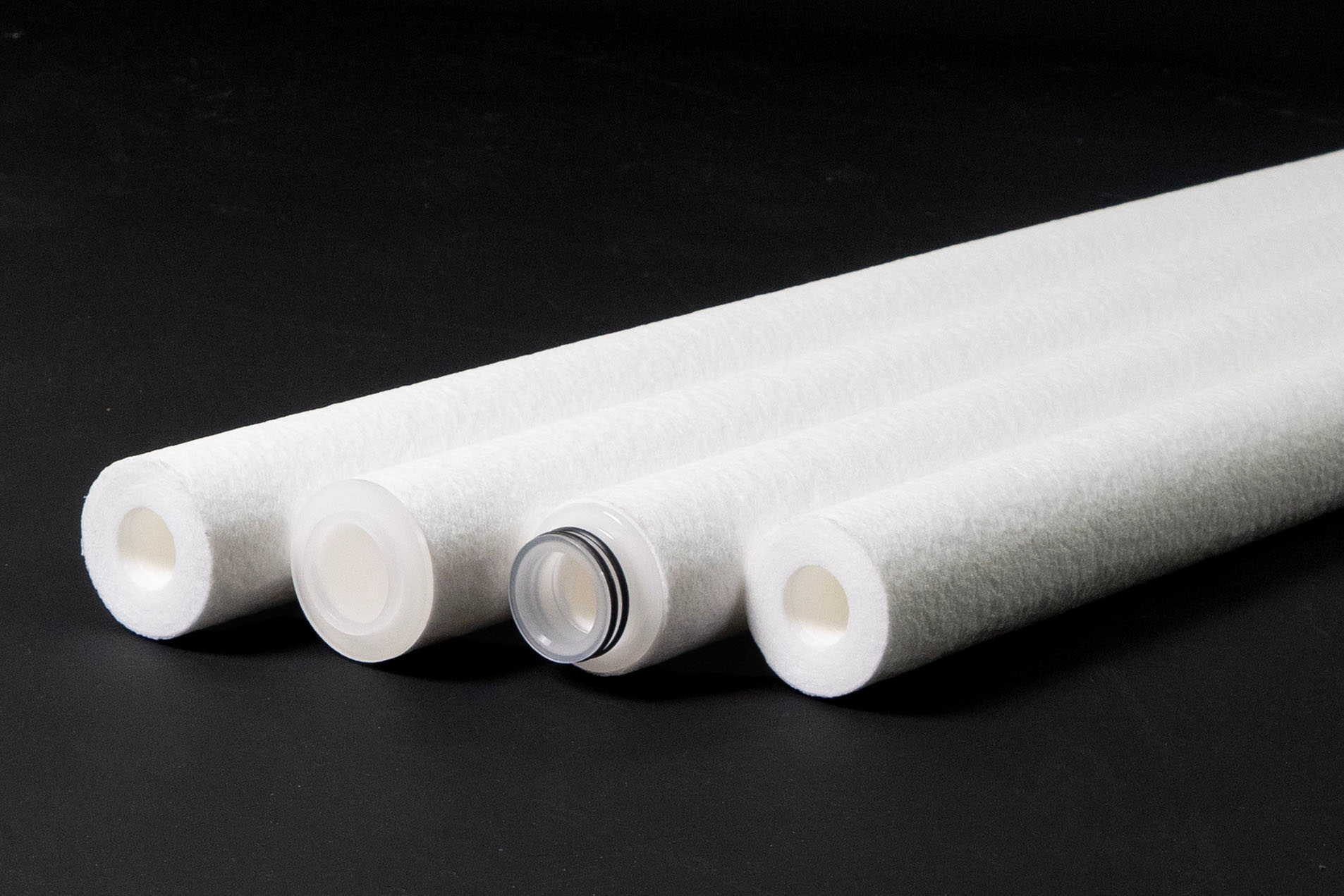
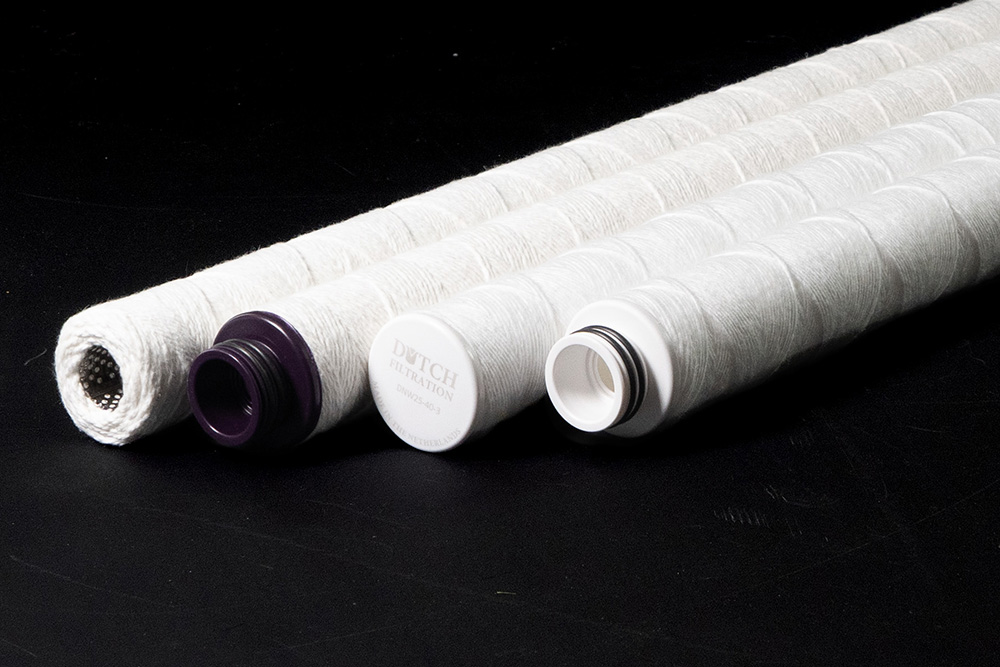

There are different types of filter elements:
- Pleated cartridge (surface filter)
- Spunbonded/Meltblown cartridge (depth filter)
- String Wound cartridge (depth filter)
- Bags (surface filter)
- Membrane (surface filter)
Dutch Filtration offers almost every type of cartridge for industrial processes. In addition we also have a large scope of the different type of pleated high flow cartridges (mostly pleated or wound and our Oillock oil absorption elements. In this article we will only discuss pleated, spunbonded/meltblown, string wound and bags.
How to select a filter, the different types of consumables
Pleated Cartridges
Pleated filters are made from materials like polypropylene, polyester, glass fiber or PES. The pleated sheet media creates a large surface area, so more contaminants can be captured on the surface of the filter material. These filters work best when all particles are nearly all the same size. These particles create an extra filtration layer, but when there are also larger particles they will stick to the surface increasing the differential pressure. Pleated filters are often used as pre-filtration with a micron range of 0,5 – 75, the micron rating of pleated cartridge filters is more precise than spunbonded or wound filters. In general, you select a surface filter over a depth filter when you require filtration for a narrow particle size distribution.
Some high end absolute pleated filters can be cleaned and reused a couple of times before change out, but this depends on the application. Pleated filters are made from synthetic materials and multi layered because this thicker type of material has a higher capacity to capture particles than thinner material.
Our pleated filters have a solid core and all components are Fully Thermal Bonded offering no leakage and no contamination by additives/glues, offering chemical compatibility and are suitable for most fluids, solvents, chemicals. Another advantage of thermal bonded technology is all cartridges can be used for operating at higher temperature and pressure.
Meltblown / Spunbonded Cartridges
Spunbonded or Meltblown cartridges are a very effective type of depth filter. These filters are usually made from polypropylene or nylon. Fibers are blown from a nozzle and thermally bonded on a rotating spindle. This creates a dense and permeable structure. Often the two types are named the same. Another type of depth filter is the melt blown filter, the difference between melt blown filters and spunbonded filters is in the mold construction (see figure 1.1 and 1.2) During the process of Spunbonded filters hot air flows at a cross flow of the emerging fiber, while in the melt blown process, hot air converges with the fiber as it emerges from the mold construction.
These filters can be used when for example wastewater contains various sizes of particles. Compared to pleated filters, spunbonded filters have a smaller filter area but they have the advantage of depth filtration. Due to their different layers, they can hold a large number of different size particles. So spunbonded cartridges are ideal for applications with high contaminant levels with a wide variety of particle sizes. Spunbonded filters do have micron ratings from less than 1 micron to over 100 microns. Spunbonded cartridges are a good cost-effective substitute for wound cartridges. But they aren’t suitable for many industrial applications because they can can collapse by even moderate differential pressure and at higher process temperatures.

Fig 1.1
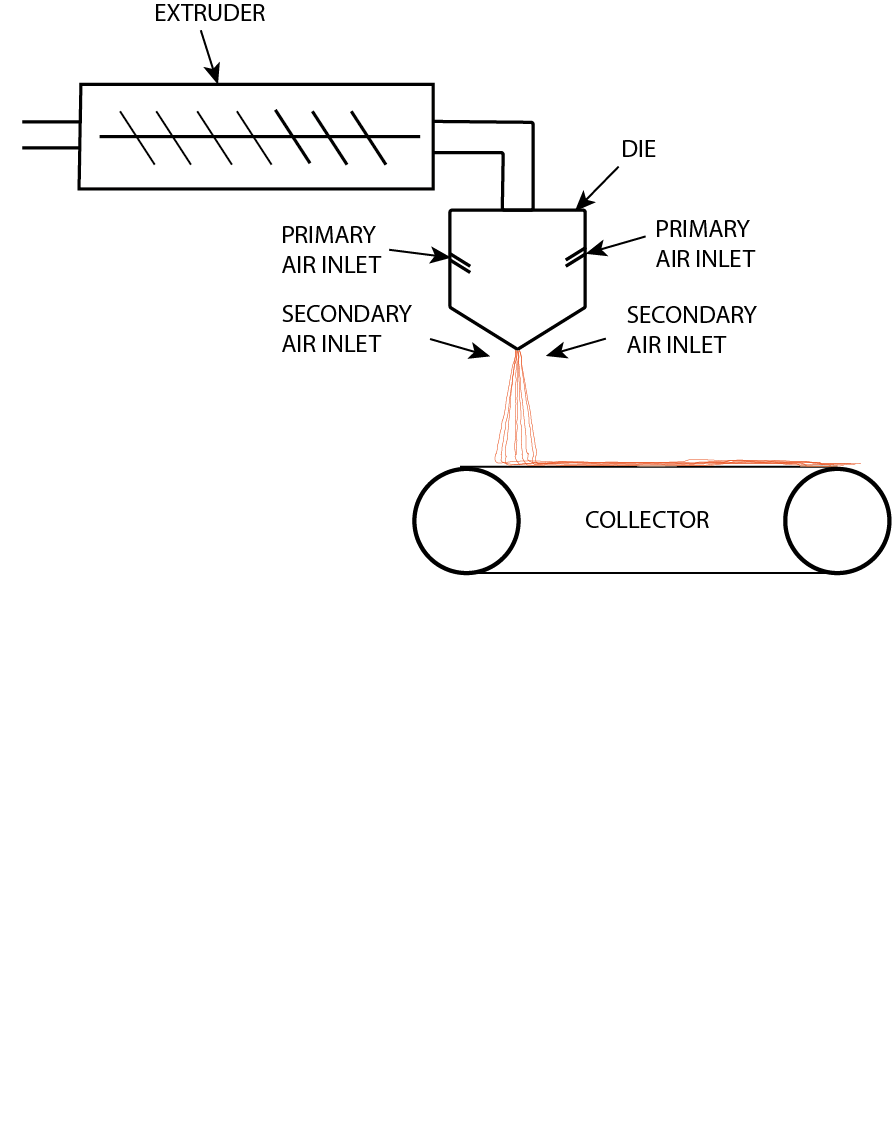
Fig. 1.2
String Wound cartridges
String wound filters use multiple layers, wound tightly over a support core in diamond/ v-shaped patterns. The first layer catches particles with same size of the micron rating or larger particles. The second inner layer catches smaller particles. This depth filtration is better athough it is at the expense of the filter surface area. So depth filters (string wound and melt-blown) need to be changed more often than pleated cartridges when the dirt particles have the same size. This type of filter cartridge works very well for fluids with a wide range of solid sizes. The wound cartridge is adaptable for many different applications and is cost-effective. It is extremely suitable for surface water filtration or pre-filtration of waste water. From all the filters mentioned above, the string wound filter is the most original, it has stood the test of time. The string wound medium is not a fixed pore matrix, as with thermally affixed pleated media. For this reason, most depth cartridges can’t handle high flow rates as pleated cartridges can. The string wound cartridges of Dutch Filtration are fully thermal bonded with end caps, and this ensures no binders, lubricants or additives leach into the filtered water.
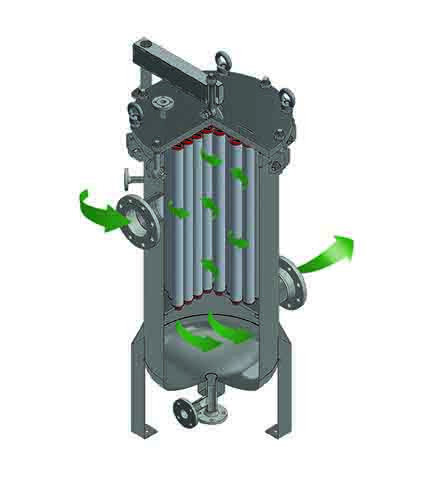
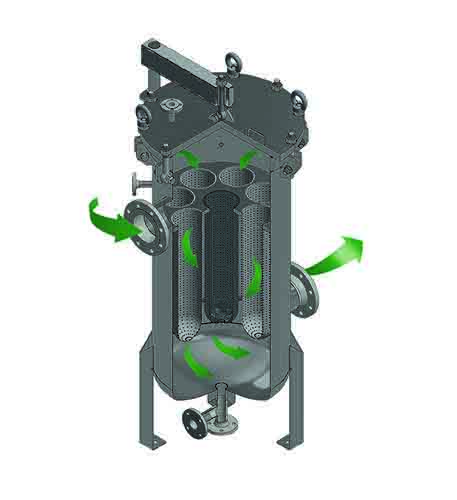
Filter Bags
In contrast to most cartridges the fluid in bag filters flows from the inside to out. This results in a lower pressure drop and higher throughput per area. Bag filters can be a low-cost option in different industries such as food and beverage production, chemical and waste water treatment and many other industries. The welded construction of filter bags supported by a stainless steel basket can handle high temperature, viscosity and chemically aggressive fluids. Bag filtration systems are therefore ideal for small batch operations or coarse filtration. When higher dirt holding capacity or flows are required with a new or existing bag filter housing it can be fitted with a high capacity filter bags and filter bags which can handle 200%. Bag filters are designed for applications with a filtration rate of 1 to 1500 micron. Available in Polypropylene, Polyester, Nylon with different style rings
Depth versus surface
The choice between the different types of filter elements, depth versus surface, often becomes a complex issue and depends on many factors.
Economics: Generally pleated filters (surface filters) cost more per 10” than depth cartridges. However, below approximately 3 micron it becomes more economical to use pleated cartridges. Pleated filters can be subjected to higher flows, so if the system needs to be sized based on flow data, they can be a more economical choice. For a high flow application fewer pleated cartridges are needed than depth filters. So this requires a smaller housing, fewer replacement cartridges and lower disposal costs.
Clarification versus classification: A depth filter can remove a wider range of particles compared to a surface filter. This type of removal is referred to as clarification, it refers to the wide range of particle sizes. A surface filter is ideal for removing a small range of particles above a specific micron rating, all particles below that rating will pass, classifying the particles of the fluid.
Flow rates/Pressure drops: As mentioned before pleated filters can handle higher flow rates than depth filters and will have lower initial pressure drops.
It’s not easy to decide which filter element is the best solution for your application. We made an overview with a couple of applications. For the best solution always contact us so we can help you with your choice.
Applications |
Pleated |
Meltblown |
Wound |
Bags |
Completion Fluids |
Polish Filtration | Pre-filtration | Pre-filtration | Pre-filtration |
Produced Water |
Polish Filtration | Pre-filtration | Pre-filtration | Pre-filtration |
Work Over Fluids |
Polish Filtration | Pre-filtration | Pre-filtration | Pre-filtration |
Gravel Pack Fluids |
Polish Filtration | Pre-filtration | Pre-filtration | Pre-filtration |
Wellbore Clean up Fluids |
Polish Filtration | Pre-filtration | Pre-filtration | Pre-filtration |
Water Injection |
Polish Filtration | Pre-filtration | Pre-filtration | Pre-filtration |
(Bio) diesel |
Polish Filtration/ Pre-filtration | Polish Filtration/ Pre-filtration | Polish Filtration/ Pre-filtration | Polish Filtration/ Pre-filtration |
Surface Water Intake |
Polish Filtration/ Pre-filtration | Polish Filtration/ Pre-filtration | Polish Filtration/ Pre-filtration | Polish Filtration/ Pre-filtration |
Process Water |
Polish Filtration/ Pre-filtration | Polish Filtration/ Pre-filtration | Polish Filtration/ Pre-filtration | Polish Filtration/ Pre-filtration |
Pre-filtration RO |
Pre-filtration | Pre-filtration | Pre-filtration | Pre-filtration |
Frac Fluids |
Polish Filtration | Pre-filtration | Pre-filtration | Pre-filtration |
Pipeline Flushing |
Pre-filtration | Pre-filtration | Pre-filtration | |
Waste Water |
Polish Filtration/ Pre-filtration | Polish Filtration/ Pre-filtration | Polish Filtration/ Pre-filtration | Polish Filtration/ Pre-filtration |
Organic Solvents (Chemical Industry) |
Polish Filtration/ Pre-filtration | Polish Filtration/ Pre-filtration | Polish Filtration/ Pre-filtration | Polish Filtration/ Pre-filtration |
Metal Cutting Fluids |
Polish Filtration/ Pre-filtration | Polish Filtration/ Pre-filtration | Polish Filtration/ Pre-filtration | Polish Filtration/ Pre-filtration |
Fuel Oil |
Polish Filtration | Pre-filtration | Pre-filtration | Pre-filtration |
Acids |
Polish Filtration | Pre-filtration | Pre-filtration | Pre-filtration |
Solvents |
Polish Filtration | Pre-filtration | Pre-filtration | Pre-filtration |
Amines & Glycol |
Polish Filtration | Pre-filtration | Pre-filtration | Pre-filtration |
Clean up of Algue Water |
Polish Filtration | Pre-filtration | Pre-filtration | Pre-filtration |
Vegetable- and Fruit Wash Water |
Polish Filtration | Pre-filtration | Pre-filtration | Pre-filtration |
Vegetable Oils, Vinegar |
Polish Filtration | Pre-filtration | Pre-filtration | Pre-filtration |
Paints, Varnishes |
Polish Filtration | Pre-filtration | Pre-filtration | Pre-filtration |
Petrochemicals |
Polish Filtration | Pre-filtration | Pre-filtration | Pre-filtration |
Bulk Chemicals |
Polish Filtration | Pre-filtration | Pre-filtration | Pre-filtration |
Sugars |
Polish Filtration | Pre-filtration | Pre-filtration | Pre-filtration |
Pleated cartridges |
Meltblown Cartridges |
Wound Cartridges |
Bags |
|
Short description |
Pleated glass fibre or polypropylene, with inner core. All components are thermally bounded.
|
Fibres blown and thermally bonded on a splindle.
|
The unique string winding pattern provides true depth filtration, | Bags, standard needle felt, welded seams, mesh pleated and multilayer felt with rigid or snap ring |
Micron ratings |
0,5 – 100 micron
|
1-50 micron
|
1-100 micron
|
1-1500 micron
|
Inner core |
Yes, polypropylene |
No standard
|
Yes, polypropylene. Stainless steel on request
|
Not applicable
|
Material components |
Caps and core polypropylene
|
Caps Polypropylene
|
Caps and core polypropylene
|
Polyester, polypropylene, nylon
|
Flow rate |
6 m3/hr (26 GPM)40 inch
|
5 m3/hr / 40inch cartridge (22 GPM) | 6 m3/hr / 40 inch cartridge (26 GPM) |
18,4 (80 GPM)– 40 m3/hr(180GPM)
|
Nominal or absolute |
Absolute |
Nominal and Absolute
|
Nominal
|
Nominal
|
Connections |
3, 8 and DOE
|
3, 8 and DOE
|
3, 8 and DOE
|
Carbon steel ring, rigid ring, polypropylene ring, polypropylenen welded ring
|
|
Filter media
|
Glass fiber or polypropylene
|
Polypropylene or Nylon
|
Cotton, Polypropylene, Glass fiber, Nylon or PPS
|
Polyester, polypropylene, nylon
|
|
Cartridge costs
|
More expensive then depth but hold more dirt so fewer replacements
|
More economical then pleated, but hold less dirt
|
More economical then pleated, but hold less dirt
|
Most economic per bags but low surface area
|
Housing costs |
Fewer cartridges – smaller housings
|
More cartridges – bigger housings
|
More cartridges – bigger housings
|
More expensive than housing for pleated due to smaller surface area
|
* in these table we don’t discuss our Oil absorption and High flow cartridges

